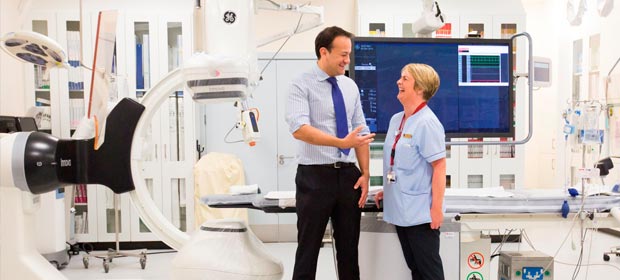Ms. Patricia King and Ms. Breedge Finn describe how Beaumont Hospital, Dublin changed how it delivers cardiac interventional services – a change project on the background of technological advances.

Currently there is an extensive range of Cardiology services at Beaumont Hospital that are provided by five consultant cardiologists with specialist interests in interventional cardiology, electrophysiology, imaging, heart failure and in general cardiology.
Up until recently cardiac interventional, electrophysiology and invasive procedures in Beaumont have been carried out in a single cardiac interventional suite (Cathlab). Beaumont Hospital has the only Cathlab within the RCSI Hospitals Group. However with the proposed refurbishment of the existing Cathlab and the development of a second Cathlab in Beaumont, funded by the HSE, an opportunity arose to fundamentally review work processes and the service delivery model in light of the opportunities presented by the new technology. Beaumont has a tradition of using the opportunity of technological advances to institute fundamental work practice changes that ultimately allow for optimal benefit to be gained from technology. These changes are undertaken with the engagement of staff, particularly those working directly in the area.
Beaumont has a tradition of using the opportunity of technological advances to institute fundamental work practice changes.
Therefore the proposed refurbishment of the first Cathlab and the development of the second Cathlab in Beaumont gave rise to a formal project for whole systems change and service development which incorporated the following workstreams:
- Physical infrastructure in conjunction with GE
- Process and workforce development
- Capacity & demand analysis
- IT infrastructure
The outcome of which was tasked to deliver:
- A modern technologically advanced cardiac interventional suite which was able to deliver cardiac interventions within an appropriate environment and in which staff were trained to utilise the equipment to its full capability.
- High quality safe patient care
- Streamlined processes
- Improved access to interventions to manage chronic cardiac conditions.
- Improved response to Emergency Department (ED) patients and inpatient consults thus improving length of stay and patient flow through the ED.
- Reduction in mean length of stay for acute coronary syndrome patients.
- Reduction in waiting times for acute cardiology intervention.
- Reduction in waiting times for chronic coronary conditions.
- Improvements in patient pathways through ED and wards.
- Expansion in use of protocols of care to aid management and discharge.
There is significant improvement in the documentation in real time and improved monitoring and recording of all interventions.
The project utilised, as an underpinning guiding framework, the HIQA Quality and Patient Safety Framework in particular:
- Theme 3: Effective Care, Standard 2.6 Core Quality Element – 17 Appropriate service delivery model
- Theme 6: Use of resources , Standard 7.1 – 5.5 Effective Resource Management
The project team found that this framework was a very effective focus for all the work of the various workstreams and kept the focus always on the patient and quality of care.
So what has been achieved?
- Modern technologically advanced cardiac interventional suite with two Cathlabs.
- Increased reliability of availability of Cathlab compared to the single old Cathlab which had significant scheduled and unscheduled downtime. Improved continuity of service.
- Significant changes in work processes for all the staff working in the cardiac interventional service which were designed and agreed by the staff.
- Due to the level of integration of medical devices within the technology, there is significant improvement in the documentation in real time and improved monitoring and recording of all interventions. The integrated approach combined with more sophisticated technology supports a safe environment which has a robust record of the patient’s treatment.
- Clinical professionals are able to fully utilise their skills and expertise therefore enhancing patient safety and quality and improving job satisfaction.
- Identification that to fully manage the existing demand for the Beaumont Hospital catchment area in a streamlined timely manner, an increase in activity of 30% is required. Currently within the organisation there are multiple targets that need to be achieved for both elective and emergency patients to adhere to the SDU, HSE and CompStat framework and to achieve the desired outcomes of the numerous Clinical Care Programmes that are underway – The full commissioning of the second Cathlab is a key enabler to the above being achieved.
- Clear identification of the additional resources required to commission the second Cathlab on the basis of the new streamlined, technology enabled, work practices. An enabling resource of an additional Interventional Cardiologist as part of the HSE Acute Coronary Syndrome Clinical Care Programme has already been provided.
- Development of a business case to support full commissioning of the additional capacity.
- Identification of the opportunities available to facilitate changes in cardiac interventional services within the Hospital Group in the future.
- Integration of new IT systems with existing IT infrastructure.
- Supports Beaumont in its position as an academic teaching hospital to meet its requirements as a training body.
- Greater understanding of team roles and improved team working. A total of 40 staff were directly involved in this project across the organisation, leaders from Medical Physics and Clinical Engineering, Non Invasive Cardiology, Senior Nursing, IT and Radiation Safety worked with the multidisciplinary groups to bring about the change. The team also developed a clear understanding that this scale of involvement is required to get the right solution for quality and safe patient care.
- Building of new skills and knowledge of the project team in areas such as project management, workforce planning, business case development, process mapping and so much more.
- Sense of achievement and pride in what has been achieved, what is currently being delivered and what can further be developed in the future.
- An official launch by Minister for Health, Dr. Leo Varadkar which allowed time to recognise and celebrate the achievements of all involved.
Patricia King, Business Manager Medical Directorate, Joint Project Manager.
Breedge Finn, CNMII, Cardiology Services, Joint Project Manager.

